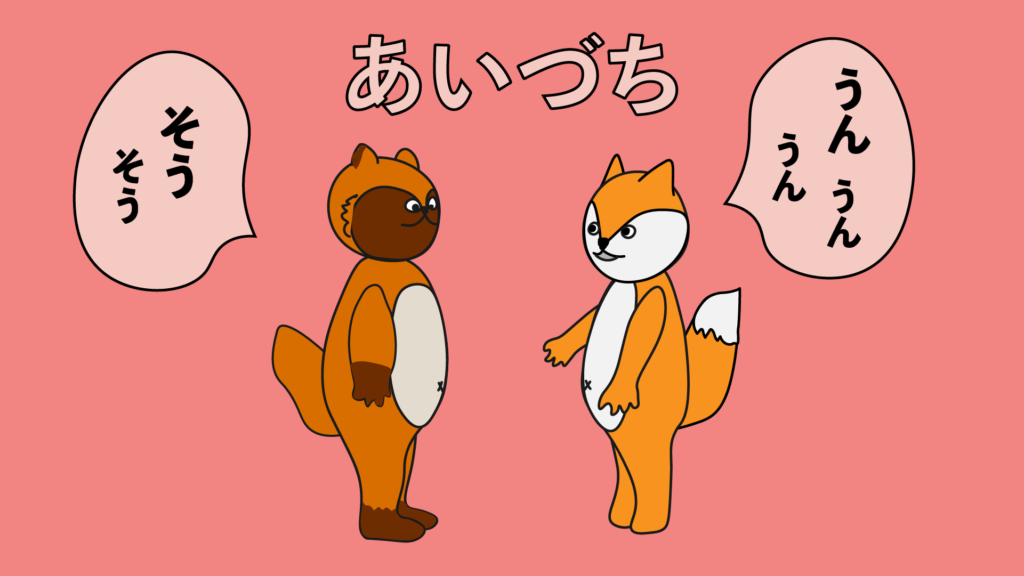Aizuchi: A special Japanese conversation technique!

What is Aizuchi?
Aizuchi (相槌) is a unique technique in Japanese conversations! They are interjections that are used to show that you’re listening to the other person.
In English, we might say “I see” or “really?” to respond to what someone is saying. In Japanese, these responses happen more frequently and it’s an important part of the culture. If you can use this technique well, it will elevate your Japanese conversation skills!
Types fo Aizuchi:
Aizuchi can fall into different categories depending on what kind of response you want to make to the conversation. Keep in mind that there are variations in formality. It’s important to choose the correct one depending on who you’re talking with and how polite you should speak.
To show your understanding
-
なるほど – naruhodo – I see… / that makes sense
Use naruhodo to express that you understand what the other person is saying. This one is informal, so only use it casually and not with those who are older or of higher hierarchy.
Sample conversation:
A:ネットで調べると答えが書いてあるよ。
Netto de shiaraberuto kotae ga kaite aru yo.
If you look it up on the internet, the answer is there.
B: なるほど!調べてみる。
Naruhodo! shirabete miru.
That makes sense! I’ll look it up.
-
へー – hee – I see…
This is an informal word that works like the word “I see”. It’s usually characterized by holding out the e longer than normal to add emphasis.
Sample conversation:
A: 昨日は一日忙しかった!
Kinou wa ichinichi isogashikatta!
Yesterday I was busy all day!
B: へー、何してたの?
hee, nani shitetano?
I see, what were you doing?
-
ふーん – fuun – I see…
This aizuchi can be used interchangeably with へー, and it’s also informal. You should use this only with your friends and family!
Sample conversation:
A: 近くのケーキ屋さんでデザート買ってみた。
Chikaku no keeki yasan de dezaato kattemita.
I bought a desert at the local cake shop.
B: ふーん、どんなケーキ?
Fuun, donna keeki?
I see, what kind of cake?
-
そうなんだ – sounanda – I see…
Sounanda is informal and can express an understanding of the other person. It can be used in situations when you want to show your support to someone else.
Sample conversation:
A:昨日大統領が決まったらしいよ。
Kinou daitouryou ga kimatta rashiiyo.
I heard they chose the president yesterday.
B:そうなんだ。最近テレビ見てないから知らなかった!
Sounanda. Saikin terebi mitenaikara shiranakatta!
I see. I haven’t watched T.V. lately so I didn’t know!
-
そうですか – soudesuka – I see…
This is a formal phrase that means “I see”. This can be used in polite situations.
Sample conversation:
A: 必要な部品がまだ届いていません。
Hitsuyou na buhin ga mada todoite imasen.
The parts that I need still haven’t arrived.
B: そうですか、困りましたね。
Soudesuka, komarimashitane.
I see, that’s problematic.
Express disbelief or surprise
-
マジ – maji – for real?
This is a slang aizuchi that can be used when you’re really surprised. However, it can be very informal and is not suitable for professional situations. If you’re hanging out with friends, try this one out!
Sample conversation:
昨日車を買った!
Kinou kuruma o katta!
I bought a car yesterday!
B: マジ?どんな車?
Maji? Donna kuruma?
For real? What kind of car?
-
本当? / 本当ですか – hontou? / hontou desuka? – Really?
本当(Hontou) means “true” so these phrases mean “is that true?” or “really?”.This can express disbelief and surprise! The two forms of the phrase have a different formality. Hontouni is casual and hontou desuka is formal.
Sample casual conversation:
A: 足の骨が折れた気がする。
Ashi no hone ga oreta kiga suru.
I think I broke my leg.
B: 本当?早く病院に行った方がいいよ!
Hontou ni? Hayaku byouin ni itta houga iiyo!
Really? You should hurry to the hospital.
Sample formal conversation
A: 足の骨が折れた気がします。
Ashi no hone ga oreta ki ga shimasu.
I think I broke my leg
B:本当ですか?早く病院に行った方がいいですよ。
Hontou desuka? Hayaku byouin ni itta houga ii desu yo.
You should hurry to the hospital.
-
うそ! – uso! – no way!
Another slang is uso!. This means “lie” in Japanese, and this interjection can be used to say that “this has to be a lie” or “no way”. It’s informal so it should only be used with friends and family.
Sample conversation:
A: 宝くじに当たった!
Takarakuji ni atatta!
I won the lottery!
B:うそ!いくら当たったの?
Uso! Ikura atattano?
No way! How much did you win?
-
信じられない!/ 信じられません!- shinjirarenai! / shinjiraremasen! – I can’t believe it!
This phrase uses the word shinjiru, meaning “to believe”. It’s a phrase that can be both informal and formal.
Sample casual conversation:
A:昨日お店でお財布が盗まれた!
Kinou omise de osaifu ga nusumareta!
Yesterday, my wallet got stolen at the store!
B:信じられない!警察に連絡した方がいいよ!
Shinjirarenai! Keisatsu ni renraku shita houga iiyo!
I can’t believe it! You should contact the police!
Sample formal conversation:
A:昨日お店でお財布が盗まれました。
Kinou omise de osaifu ga nusumaremashita.
Yesterday my wallet was stolen.
B:信じられません!警察に連絡した方がいいですよ。
Shinjiraremasen! Keisatsu ni renraku shita hou ga iidesuyo.
I can’t believe it! You should contact the police!
-
すごい! / すごいですね!- sugoi! / sugoi desune! – Wow!
If you’re expressing surprise in a positive way, sugoi is a great word! It’s possible to use it in both formal and informal contexts. Make sure that you only use this in a positive situation.
Sample casual conversation:
A: 今日の試合を勝った!
Kyou no shiai o katta!
I won today’s match!
B: すごい!相手のチームは強かった?
Sugoi! Aite no chiimu wa tsuyokatta?
Wow! Was the other team strong?
Sample formal conversation
A: 今日の試合を勝ちました!
Kyou no shiai o kachimashita!
I won today’s match!
B: すごいですね!相手のチーム強かったですか?
Sugoi desune! Aite no chiimu tsuyokattadesuka?
Wow! Was the other team strong?
-
えー!- ee – What?!
This word can be used to show surprise when something negative happens. Only use it in negative situations. You can use it both informally or formally, just make sure you use it in the right context or it could be rude!
Sample conversation:
A:家から追い出されました。
Ie kara oidasaremashita.
I was kicked out of my house.
B:えー!大丈夫ですか?
Ee! Daijoubudesuka?
What?! Are you ok?
To say “yes” or “ok”
-
うん – un – yes/ok
This is a very common way to say “yes” or “ok”. It can be used to express that you’re interested and listening to the other person.
Sample conversation:
A:外を歩く時は気をつけなさい。
Soto o aruku toki wa kio tsukenasai.
Be careful when you walk outside
B:うん。わかった。
Un. wakatta.
Yes/ok. I understand.
-
はい / ええ – hai / ee – yes/ok
This is similar to うん but it is more formal. You can use it in any situation without being rude.
Sample Conversation:
A:明日の会議は遅くなるかもしれません。
Ashita no kaigi wa osoku naru kamoshiremasen.
Tomorrow’s meeting might be late.
B: ええ/はい。そうかもしれませんね。
Ee/hai. Sou kamoshiremasen ne.
yes/ok. That’s a possibility.
-
そう / そうです – Sou / Soudesu – Yes
If you’re trying to say “yes” to show that the other person is doing the right thing, you can say sou or soudesu. This word can take both formal and casual forms.
Sample casual conversation:
A: ここに名前を書けばいいの?
Koko ni namae o kakebaiino?
Should I write my name here?
B: そう!そこ!
Sou! Soko!
Yes! There!
Sample formal conversation:
A:ここに名前を書けばいいですか?
Koko ni namae o kakeba iidesuka?
Should I write my name here?
B:そうです!そこです!
Soudesu! Soko desu!
Yes! There!
To show agreement
-
同感!- Doukan! – I agree!
If you agree with someone, try using doukan. The kanji for this word is made from 同 (dou) meaning “same” and 感 (kan) meaning feeling. It literally translates to “same feeling”. This one is only for casual contexts unless you add a です at the end.
Sample conversation:
A:なぜか今日の夜ご飯はステーキが食べたい!
Nazeka kyou no yoru gohan wa steeki ga tabetai!
For some reason I want to eat steak for dinner!
B:同感!最近ステーキ食べてない。
Doukan! Saikin steeki tabetenai.
I agree! I haven’t had steak in awhile.
-
私もそう思う / そう思います。watashi mo sou omou / watashi mo sou omoimasu- I think the same!
This is a nice way to say that you agree, and can be in both casual and formal forms. 思う (omou) means to feel, think, or care. This choice of kanji gives it a nice caring feeling!
Sample casual conversation:
A: 外にいる猫は野良猫だと思う
Soto ni iru neko wa noraneko dato omou
I think the cat outside is a stray.
B: 私もそう思う!
Watashi mo sou omou!
I think the same!
Sample formal conversation:
A: 外にいる猫は野良猫だと思います。
Soto ni iru neko wa noraneko dato omoimasu.
I think the cat outside is a stray.
B:私もそう思います!
Watashimo sou omoimasu!
I think the same!
-
その通り / その通りです- sono toori / sono toori desu – Exactly!
This is great when you need to give words of encouragement. The phrase directly translates to “that road”. It works as a metaphor for making the correct decision! Sono touri is the casual form and sono touridesu is the formal version
Sample casual conversation:
A: 質問の答えはBだと思う。
Shitsumon no kotae wa bii dato omou.
I think the answer is B.
B:その通り!
Sono toori!
Exactly!
Sample formal conversation:
A: 質問の答えはBだと思います。
Shitsumon no kotae wa bii dato omoimasu.
I think the answer is B.
B:その通りです!
Sono toori desu!
Exactly!
-
確かに – tashikani – that’s true
If you need an aizuchi that is usable in both formal and informal contexts, this is a great choice. You can express that you agree with the other person.
Sample conversation:
A:テレビを見過ぎると、目が痛くなります。
Terebi o misugiruto, me ga itakunarimasu.
When I watch too much T.V. my eyes hurt.
B: 確かに!私も同じです。
Tashikani! Watashi mo onaji desu.
That’s true! It’s the same for me.
Mirroring phrases as an Aizuchi
Another important way to use aizuchi is by reflecting the other person’s phrase back as a question or statement. This shows that you’re listening and also that you care about what the other person is talking about.
Reflecting back as a question
If someone makes a statement, you can ask a rhetorical question that encourages the other person to speak more. Here is an example:
Sample conversation:
A:昨日新しいパソコンを買った!
Kinou atarashii pasokon o katta!
I bought a new computer yesterday!
B: パソコンを買ったの?
Pasokon kattano?
You bought a computer?
Modifying and repeating the same statement back
You can also respond by saying the same statement back with different endings like だ or ね to add different nuances. This would encourage the other person to talk more about their statement.
Sample conversation:
A: 今日は学校に行きます。
Kyou wa gakkou ni ikimasu.
I will go to school today.
B: 学校に行くんですね。
Gakkou ni ikundesune.
I see, so you’re going to school.
I hope this was helpful on how to make your Japanese conversations flow more naturally! An important part of aizuchi is the intonation of the words so make sure you’re always listening to how native speakers say them. Stay tuned for more articles on Japanese learning and feel free to check out my other articles like How to Introduce Yourself in Japanese or Filler words in Japanese: How to use them!
~ Tanuki





